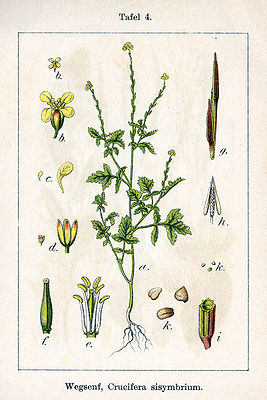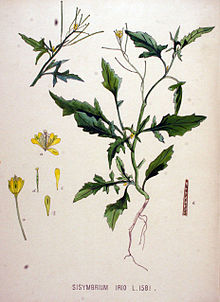Rocket
| Rocket | ||||||||||||
|---|---|---|---|---|---|---|---|---|---|---|---|---|

Rocket ( Sisymbrium officinale ), |
||||||||||||
| Systematics | ||||||||||||
|
||||||||||||
| Scientific name of the tribe | ||||||||||||
| Sisymbrieae | ||||||||||||
| DC. | ||||||||||||
| Scientific name of the genus | ||||||||||||
| Sisymbrium | ||||||||||||
| L. |
Rauks ( Sisymbrium ) are the only genus of the tribe Sisymbrieae in the plant family of the Brassicaceae (Brassicaceae). The approximately 41 species occur in the temperate areas of Eurasia and North America , as well as some species in subtropical and tropical mountain countries. In many parts of the world, some species are neophytes .
The Senfrauken , which also includes rocket , form another genus, and the species of double seeds ( diplotaxis ) are popularly called rockets.
description

Vegetative characteristics
Sisymbrium species grow as annual , biennial or perennial herbaceous plants . The parts of the plant are bare or covered with mostly simple hair. Their leaves are pinnate to undivided.
Generative characteristics
Its flowers are often umbrella- clustered at the beginning , later in cluster-like inflorescences after the inflorescence axis has been extended .
The hermaphrodite flowers are fourfold. The four sepals are at most indistinctly protruding. The four petals are obovate to spatulate and yellow. There are six stamens and the stamens are without appendages. The nectaries are arranged in a ring.
The linear pods have two one to three-veined fruit valves. The seeds stand in a row.
The basic chromosome number is x = 7.




Systematics and distribution
Sisymbrium is the only genus of the tribe Sisymbrieae in the family Brassicaceae . The tribe Sisymbrieae was created in 1821 by Augustin-Pyrame de Candolle in Mémoires du Museum d'Histoire Naturelle. Paris , Volume 7, p. 237 first published under the name "Sisymbreae".
The genus name Sisymbrium was 1753 Linnaeus in Species Plantarum , 2, pp 657-660 first published . Synonyms for Sisymbrium L. are: Alaida F.Dvorák , Coelophragmus O.E.Schulz , Dimitria Ravenna , Dimorphostemon Kitag. , Lycocarpus O.E.Schulz , Mostacillastrum O.E.Schulz , Pachypodium Webb & Berthel. , Phlebiophragmus O.E.Schulz , Velarum Rchb. , Schoenocrambe Greene . The generic name Sisymbrium is a Latinized ancient Greek name that was used by Dioscorides and Pliny for various types of "mustard".
About 41 species occur in the temperate zones of Eurasia (ten species in China, seven species in Pakistan) and North America (eight species), as well as some species in subtropical and tropical mountain countries. In many parts of the world, some species are neophytes .
There are around 41 species of Sisymbrium (here is a selection):
- Hungarian rocket , also called giant rocket ( Sisymbrium altissimum L. ): The original distribution area is in southern and eastern Europe and Asia. For example in the New World and New Zealand it is a neophyte .
- Sisymbrium assoanum Loscos & Pardo : It occurs in Spain .
- Austrian rocket ( Sisymbrium austriacum Jacq. , Syn .: Sisymbrium multisiliquosum Willk. , Sisymbrium pyrenaicum (L.) Vill. Nom. Illeg., Sisymbrium pyrenaicum subsp. Austriacum (Jacq.) Schinz & Thell. ): It is from West- to Central Europe widespread.
- Sisymbrium bilobum (C. Koch) Grossh. : It occurs in Armenia .
- Sisymbrium brassiciforme C.A. Meyer : It is distributed from Uzbekistan , Tajikistan , Turkmenistan , Kazakhstan , Kyrgyzstan , Russia , Afghanistan , via India , Kashmir , Pakistan , Nepal to Mongolia, Xinjiang and Tibet .
- Sisymbrium cavanillesianum Castroviejo & Valdés-Bermejo : It occurs in Spain .
- Sisymbrium confertum Steven ex Turcz. (Syn .: Sisymbrium anomalum Azn. , Sisymbrium lagascae Amo , Sisymbrium austriacum subsp. Thracicum Azn. ): It occurs in the European part of Turkey and in the Crimea .
- Sisymbrium crassifolium Cav. (Syn .: Sisymbrium arundanum Boiss. , Sisymbrium granatense Boiss. , Sisymbrium laxiflorum Boiss. , Sisymbrium Mario lense (Pau) Pau & Camara , Sisymbrium crassifolium Cav. Subsp. Crassifolium , Sisymbrium crassifolium subsp. Laxiflorum (Boiss.) O.Bolòs & Vigo ): It iswidespreadfrom Morocco to the Iberian Peninsula .
- Sisymbrium damascenum Boiss. : It occurs in the Middle East .
- Sisymbrium elatum K. Koch : It occurs in Armenia .
- Sisymbrium erucastrifolium (Rupr.) Trautv. : It occurs in the Caucasus region.
- Sisymbrium erysimoides Desf. (Syn .: Sisymbrium rigidulum Lag. ): It is distributed from Portugal and the Azores over North Africa to the Sinai Peninsula .
- Sisymbrium glaucescens Phil . : It is common in Argentina and Chile .
- Sisymbrium heteromallum C.A. Meyer : It is distributed from Kazakhstan via Pakistan , India , Mongolia , Russia and China to Korea .
- Shiny rocket ( Sisymbrium irio L. ): It is distributed from Europe to West Asia , Tajikistan , Turkmenistan , Uzbekistan and Afghanistan to India, Kashmir , Pakistan, Nepal to Xinjiang , Nei Mongol and Taiwan. For example, it is a neophyte in the New World and Australia.
- Sisymbrium linifolium (Nutt.) Nutt. ex Torr. & A.Gray (Syn .: Schoenocrambe linifolia (Nutt.) Greene ): It is common in North America.
- Sisymbrium lipskyi N.Busch : It occurs in the Caucasus region.
- Loesel's rocket ( Sisymbrium loeselii L. ): It is widespread from Central and Eastern Europe to Asia. She is a neophyte in North America.
- Sisymbrium luteum (Maxim.) OESchulz : It is common in China, Korea , Japan and Russia's Far East.
- Sisymbrium macroloma Pomel : It is common in Western Europe in Spain and France.
- Sisymbrium maurum Maire : It occurs in Morocco.
- Rocket ( Sisymbrium officinale (L.) Scopoli ): It is common in Eurasia and North Africa. It is a neophyte in many areas of the world.
- Oriental rocket ( Sisymbrium orientale L. , Syn .: Sisymbrium costei Foucaud & Rouy , Sisymbrium columnae Jacq. , Sisymbrium longesiliquosum Willk. , Sisymbrium subhastatum (Willd.) Hornem. ): It is widespread in Eurasia and North Africa. She is a neophyte in the New World.
- Rich-leaved rocket ( Sisymbrium polyceratium L. ): It is widespread in the Mediterranean region.
- Sisymbrium polymorphum (Murray) Roth (Syn .: Sisymbrium junceum M.Bieb. ): It is widespread from Eastern Europe (Kazakhstan, Tajikistan, Kyrgyzstan), Russia and Mongolia to China.
- Sisymbrium reboudianum Verl .: It occurs in Morocco.
- Sisymbrium runcinatum Lag. Ex DC. (Syn .: Sisymbrium hirsutum DC. ): It occurs from North Africa across the Iberian Peninsula to France.
- Sisymbrium septulatum DC. (Syn .: Sisymbrium bilobum (K. Koch) Grossh. , Sisymbrium rigidulum Decne. ): It occurs in Western Asia.
- Stiff rocket ( Sisymbrium strictissimum L. , Syn .: Sisymbrium nitidulum Spreng. ): It is widespread from France across Central and Eastern to Southeastern Europe.
- Lower rocket ( Sisymbrium supinum L. ): It occurs only in Europe in France, in Switzerland, in the Baltic States and Eastern Europe as well as in southern Sweden. It used to occur in West Germany, Belgium and the Netherlands.
- Volga rocket ( Sisymbrium volgense M.Bieb. Ex E. Fourn . ): It occurs in Eastern Europe and is a neophyte in some other areas in Europe.
- Sisymbrium yunnanense W.W.Smith (Syn .: Sisymbrium luteum var. Yunnanense (WWSmith) OESchulz. ): It thrives at altitudes of 2000 to 3000 meters in the Chinese provinces of Sichuan and Yunnan .
swell
- Ihsan A. Al-Shehbaz: Brassicaceae. : Sisymbrieae , p. 666 - the same text online as the printed work , in: Flora of North America Editorial Committee (Ed.): Flora of North America North of Mexico. Volume 7: Magnoliophyta: Salicaceae to Brassicaceae , Oxford University Press, New York and Oxford 2010, ISBN 978-0-19-531822-7 . (Sections Description, Distribution and Systematics)
- Tai-yien Cheo, Lianli Lu, Guang Yang, Ihsan Al-Shehbaz, Vladimir Dorofeev: Brassicaceae. : Sisymbrium , p. 177 - online with the same text as the printed work , in: Wu Zheng-yi, Peter H. Raven (Ed.): Flora of China. Volume 8: Brassicaceae through Saxifragaceae , Science Press and Missouri Botanical Garden Press, Beijing and St. Louis 2001, ISBN 0-915279-93-2 . (Sections Description and Systematics)
- Karol Marhold, 2011: Brassicaceae. Datasheet at Euro + Med Plantbase - the information resource for Euro-Mediterranean plant diversity .
Individual evidence
- ↑ a b Ihsan A. Al-Shehbaz: Brassicaceae. : Sisymbrieae , p. 666 - the same text online as the printed work , In: Flora of North America Editorial Committee (Ed.): Flora of North America North of Mexico. Volume 7: Magnoliophyta: Salicaceae to Brassicaceae , Oxford University Press, New York and Oxford 2010, ISBN 978-0-19-531822-7 .
- ^ Sisymbrieae in the Germplasm Resources Information Network (GRIN), USDA , ARS , National Genetic Resources Program. National Germplasm Resources Laboratory, Beltsville, Maryland.
- ↑ a b c d e f g h i j k l m n o p q Karol Marhold, 2011: Brassicaceae. Datasheet at Euro + Med Plantbase - the information resource for Euro-Mediterranean plant diversity .
- ↑ a b c d e f g Tai-yien Cheo, Lianli Lu, Guang Yang, Ihsan Al-Shehbaz, Vladimir Dorofeev: Brassicaceae. : Sisymbrium , p. 177 - online with the same text as the printed work , In: Wu Zheng-yi, Peter H. Raven (Ed.): Flora of China. Volume 8: Brassicaceae through Saxifragaceae , Science Press and Missouri Botanical Garden Press, Beijing and St. Louis 2001, ISBN 0-915279-93-2 .
- ↑ David Aeschimann, Konrad Lauber, Daniel Martin Moser, Jean-Paul Theurillat: Flora alpina. Volume 1 and 2. Bern, Haupt-Verlag, Stuttgart, Vienna 2004, ISBN 3-258-06600-0 .
- ↑ Rolf Wisskirchen, Henning Haeupler: Standard list of fern and flowering plants in Germany. Ulmer, Stuttgart 1998, ISBN 3-8001-3360-1 .
- ↑ Jaakko Jalas, Juha Suominen: Atlas florae europaeae. Volume 10 Cruciferae (Sisymbrium to Aubrieta). Helsinki 1994, ISBN 951-9108-09-2 , pp. 15-29.
- ^ Oskar Sebald, Siegmund Seybold , Georg Philippi (ed.): The fern and flowering plants of Baden-Württemberg. Volume 2: Special part (Spermatophyta, subclass Dilleniidae): Hypericaceae to Primulaceae. 2nd expanded edition. Eugen Ulmer, Stuttgart 1993, ISBN 3-8001-3323-7 .
